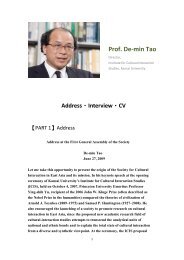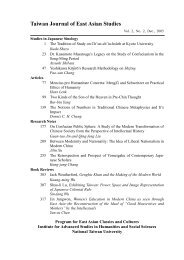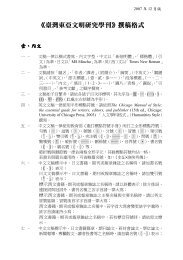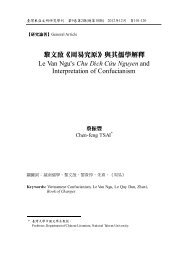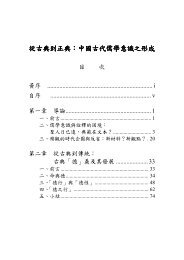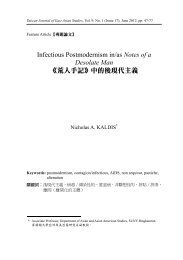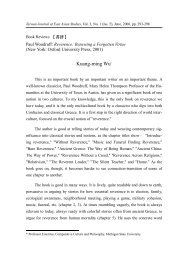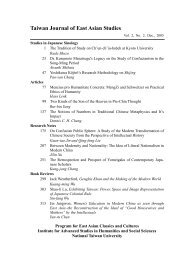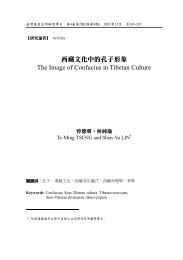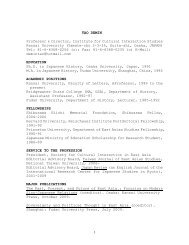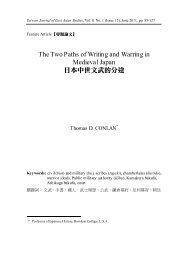臺灣東亞文明研究學刊 - 東亞經典與文化研究計畫 - 國立臺灣大學
臺灣東亞文明研究學刊 - 東亞經典與文化研究計畫 - 國立臺灣大學
臺灣東亞文明研究學刊 - 東亞經典與文化研究計畫 - 國立臺灣大學
You also want an ePaper? Increase the reach of your titles
YUMPU automatically turns print PDFs into web optimized ePapers that Google loves.
蔡 源 林 劉邟 智醳 《 天 方尣 性 理 》 對 宗 教 「 他 者 」 的 建匔 構庂 57<br />
Abstract<br />
The main theme of this article arises from a critical reflection on Rudolf<br />
Otto's discourse of God as the "wholly Other." Otto's idea, instead of<br />
developing a theoretical framework of bridging the gap between the Western<br />
and Eastern religions, illuminates the uniqueness of the Abrahamic<br />
monotheism. It requires a more dialectical way of thinking to develop such a<br />
comparative framework. This reflection leads the author to investigate the<br />
Chinese Muslim tradition in order to open another possibility to compare<br />
between the Western and Eastern ideas of divinity. Liu Zhi (1660?-1730?),<br />
the most prolific Chinese Muslim scholar in the Ming-Qing era, is an<br />
unprecedented cross-traditional thinker. His works provide the rich sources<br />
to search for the new ground of both the study of comparative religion and<br />
inter-faith dialogue.<br />
The first section quotes from the Qur‘ān to illustrate Otto's "wholly<br />
Other" and to base Liu Zhi's philosophy upon the Islamic tradition; the<br />
second describes Liu's life and intellectual background, in which the<br />
Jingtang education and Sufism are emphasized; the third elaborates the<br />
"True One" in Liu's Tianfang Xingli (The Islamic Philosophy of Nature and<br />
Principle) and traces the two views of divinity in Liu's work, dualism and<br />
holism, toward the two intellectual traditions of Islam, Sunni theology and<br />
Sufi mysticism; the latter plays a significant role for Liu to develop a<br />
theoretical framework of comparing Islam and the three Chinese teachings;<br />
the last discusses the metaphysical implication of prophethood in Tianfang<br />
Xingli and how the Prophet Muhammad owns the "Ultimate Sainthood"<br />
which stands at the intermediate position between the sacred and the secular,<br />
the Creator and the created world, and would be the perfect model for<br />
humankind to achieve redemption.<br />
iii



